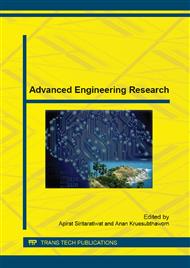[1]
C. Tang, F. You, G. Cheng, D. Gao, F. Fu , X. Dong, Modeling the frequency dependence of the electrical properties of the live human skull, Physiol. Meas. 30 (2009) 1293–1301.
DOI: 10.1088/0967-3334/30/12/001
Google Scholar
[2]
B.M. Vinagre, V. Feliu, Optimal fractional controllers for rational order systems: a special case of the Wiener-Hopf spectral factorization method. IEEE Trans. Automat. Contr. 52 (2007) 2385–2389.
DOI: 10.1109/tac.2007.910728
Google Scholar
[3]
L. Dorcak, J. Valsa, J. Terpak, I. Petras, E. Gonzalez, Comparison of the electronic realization of the fractional-order systems and its model, Proc. 2012 13th ICCC. (2012) 119–124.
DOI: 10.1109/carpathiancc.2012.6228627
Google Scholar
[4]
A.S. Elwakil, B. Maundy, Extracting the cole–cole impedance model parameters without direct impedance measurement, Electron. Lett. 46 (2010) 1367–1368.
DOI: 10.1049/el.2010.1924
Google Scholar
[5]
J. Wu, C. Chen, A new operational approach for solving fractional calculus and fractional differential equations numerically, IEICE Trans. Fund. Electron. Comm. Comput. Sci. E87 (2004) 1077–1082.
Google Scholar
[6]
B.T. Krishna, K.V.V.S. Reddy, S. Santha Kumari, Time domain response calculations of fractance device of order 1/2, J. Act. Pass. Electron. Dev. 3 (2008) 355–367.
Google Scholar
[7]
A.S. Elwakil, Fractional order circuits and systems: An emerging interdisciplinary research area, IEEE Circuits Syst. Mag. 10 (2010) 40-50.
DOI: 10.1109/mcas.2010.938637
Google Scholar
[8]
A.G. Radwan, A.S. Elwakil, An expression for the voltage response of a current-excited fractance device based on fractional-order trigonometric identities, Int. J. Circ. Theor. App. 40 (2012) 533-538.
DOI: 10.1002/cta.760
Google Scholar
[9]
R. Matusu, Application of fractional order calculus to control theory, Int. J. Math. Mod. Meth. Appl. S. 5 (2011) 1162-1169.
Google Scholar
[10]
A.D. Polyanin, A.V. Manzhirov, Handbook of Mathematics for Engineers and Scientists, Chapman and Hall/CRC, London, (2006).
Google Scholar


